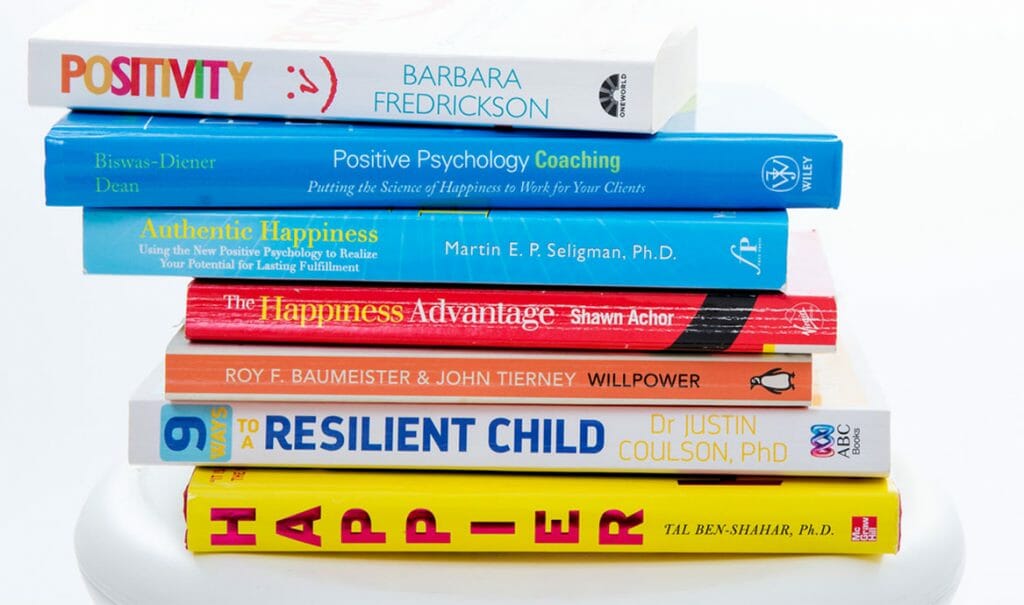 I read a lot. My latest book is one of my favorites, Positivity by Barbara Fredrickson. I’ve been aware of her work for a long time, but reading her book has brought her research to life and really highlighted why positivity is so important! Below I’ve summarised what I found to be the key elements of the book, if you love it, I suggest grabbing the book and checking it out for yourself.
I read a lot. My latest book is one of my favorites, Positivity by Barbara Fredrickson. I’ve been aware of her work for a long time, but reading her book has brought her research to life and really highlighted why positivity is so important! Below I’ve summarised what I found to be the key elements of the book, if you love it, I suggest grabbing the book and checking it out for yourself.
Fredrickson starts with a few facts about positivity:
1. Positivity feels good
2. Positivity changes how your mind works
3. Positivity transforms your future
4. Positivity puts the brakes on negativity
5. You can increase your positivity
Flourishing means people are functioning at extraordinarily high levels; They are highly satisfied with their lives, experience pleasant emotions often, are highly engaged with their families, work and communities, are adding value to the world and have a strong sense of purpose.
Positivity transforms us, providing more physical, social, intellectual and psychological resources.
Fredericks and defines 10 forms of positivity: joy, gratitude, serenity, interest, hope, pride and amusement, inspiration, and love.
• Joy feels light and bright, and brings a spring to your step. When your face lights up with a smile and you feel an inner glow, this is Joy.
• Gratitude comes when you appreciate something that’s truly important to you, it opens up your heart and carries with it the urge to give back and do something good.
• Serenity is a deep comfort and contentment knowing that life is full, calm and peaceful.
• Interest is where something grabs your attention and makes you move forward, it leads you to explore, to discover and to find flow in everyday life.
• Hope is the belief and feeling that something will get better and that things can change.
• Hope sparks motivation and can bring brightness to the darkest of days.
• Pride comes when you know you’ve done something well. You’ve achieved or pursued on a difficult task.
• Amusement is a largely social emotion, it keeps your interest and connects you to other people, helping you laugh and smile more often.
• Inspiration is the way we feel when we see somebody else doing good or we do something good ourselves. We feel motivated towards improving things and compelled to make life better.
• Awe is a feeling we associate with something wonderous or beautiful. When we see a sunrise or a pod of dolphins we can feel completely humbled and at the same time marvel at the world’s grace and beauty, feeling part of something much larger than ourselves and connected to a greater good.
• Love is the most profound emotion of all. It encompasses joy, gratitude, serenity, interest, hope, pride, amusement, inspiration, and awe. Love changes the chemical reactions in your body and raises the oxytocin and progesterone levels, it builds trust, intimacy and connection. It is often said that love is what makes life worth living.
Students who are primed for a positive emotion consistently do better on standardized tests and managers with greater levels of positivity are more accurate and careful in making their decisions and display higher interpersonal skills. Further research indicates that people who come to negotiations with more positivity generally walk away striking the best business deals.
People who have more positivity in their lives are more able to cope with adversity in an open way and to see more opportunities and solutions to deal with the problem. Positivity and trust feed on each other. As our positivity increases so does our trust in others and vice versa. Positivity broadens people’s views of themselves.
People with higher positive emotions are much broader minded and much less likely to hold prejudices. The more we feel good and experienced positivity, Alice Islen found, the more likely we are to be kind and offer help to strangers. Positivity and kindness go hand in hand. The more positive we feel the more kindness we create.
Our body’s cells are continually regenerating, this includes our brain. Emotions provide a key signal to the brain to keep growing. Positivity promotes cell growth whereas negativity prompts cell decay. When people meditate for over 3 weeks consistently they will experience a rise of each of the top ten emotions, even though the loving kindness meditation is focused solely on improving love.
The hedonic treadmill describes how our experience gradually diminishes over time. Whether it’s winning the lotto or losing a limb, within 3 to 12 months we will find the new situation completely normal and its effect on our positivity or negativity will diminish to nothing.
People who meditate regularly experienced 4 improvements. 1. They gained mental resources becoming better at focusing and savoring upcoming pleasant events. 2. They gained psychological resources, becoming more accepting of themselves and their lives as more purposeful. 3. They gained social resources forging deeper and more trusting relationships and feeling more support from others. And 4. They gained physical resources, they were healthier. People judged their lives to be more satisfying and fulfilling after mindfulness and they experienced fewer signs of depression.
Positivity builds enduring mental habits of openness, it’s energizing for other people to be around you and it has a large impact on your attractiveness to others. Positivity is contagious and ignites joy in others, forging stronger social ties and connections. Couples who showed high levels of positivity to each other build up important reserves to help them weather the inevitable hardships that they will face. Statistically, positive couples are far less likely to get divorced.
Positivity predicts lower stress related hormones and higher levels of growth-related and bond related hormones. Positivity creates more dopamine and opioids, enhancing immune system function and diminishing inflammatory responses to stress. Positivity brings with it lower blood pressure, less pain, fewer colds and better sleep. People high on positivity also have lower disease risks and a less likely to experience hypertension, diabetes or stroke. Positivity predicts longevity.
Kathleen Light an internationally acclaimed scientist has done groundbreaking work on how hugs and other forms of physical affection affect our health. People who get hugs everyday have higher circulating levels of oxytocin and lower blood pressure than everybody else.
Fredrickson and her team discovered that resilience and positivity go hand in hand. Without positivity, there is no rebound. People who score exceptionally high on resilience surveys, rather than succumbing to negativity, actually retain their positivity. Their emotions are more complex because their positivity, optimism and hope sit side by side with their negativity. Good feelings not only flush out negativity, they also quiet your heart and bring your blood pressure back to normal.
People were put in stressful situations and then shown various videos (one with a playful puppy, one stressful and another with a calm ocean.) Researchers found people who viewed the positive video, with the playful puppy, showed the highest reduction in stress symptoms. Showing that positivity, quite literally, can undo the harmful effects of stress. Positivity gives people the ability to reset many negative emotions. Resilient people spend less time worrying about the future and are more in tune with what’s happening in the present moment. They don’t over generalise or overreact. Openness goes hand in hand with resilience, and the more positive emotions people experienced the more their resilience levels grow.
When people approach difficult tasks with enthusiasm, excitement and energy, their stress gets translated into hope. Positivity runs between us just as much as it runs within us. There are two basic responses to hardship: despair or hope. With despair, negativity multiplies and your fear and uncertainty turns into stress, in turn developing into hopelessness, sadness, shame, anxiety or depression. Hope however acknowledges negativity, yet rekindles optimism and a belief in a better future.
The positivity ratio acts like a tipping Point. Ice and water are the same substance but one is solid, rigid and immobile and the other is liquid, flexible and dynamic. The only difference between the two is a change of temperature, this is the tipping point that turns ice into water or water into ice.
Our positivity ratio acts in the same way, when you experience three positive emotions to every one negative emotion (3:1) your life moves into an upward spiral towards well-being. If you experience less than three positive emotions to every one negative emotion your life simply can’t spiral in an upwards direction and will remain in a holding pattern at best.
Marshall Losada studied the characteristics of high performing business teams. He tracked three dimensions; 1. If teams statements were positive or negative, 2. If they were self-focused or other focused, and 2. If comments were based on enquiry (asking questions) or advocacy (making statements.) Losada found that the tipping Point (or positivity ratio) was over 5 positive emotions to every one negative (5:1) The teams that experienced this ratio were creative, connected and responsive to one another. The positive teams remained flexible during challenges, were more responsive to each other and experienced much more success in the long term.
Most people’s positivity ratios are generally more positive and hover around two positive emotions to every one negative. Although they are indeed more positive this still is not enough to feed the momentum to flourish. The few who do enjoy flourishing lives, experience positivity ratios upward and beyond 3 to 1. This is considered a vital tipping point.
John Gottman, renowned relationship researcher, found that relationships or marriages that were falling apart or ended in divorce, experienced a ratio of one positive emotion to one negative (1:1.) whereas marriages and relationships that were flourishing experienced a ratio of upward of five positive emotions to every one negative (5:1.)
Three researches; Barbara Fredrickson, Marshall Losada, and John gottman, all found very similar positivity ratios between individuals, teams and within marriages. Consider the positivity ratio a little like a sailboat, three parts of the sailboat are above water but one part, the keel must remain below water to keep the boat upright. It’s the negative that keeps the positive in balance and just like the sailing boat, to be able to move forward in life you must have this ratio in order. Funnily enough shifting our positivity ratio may actually depend upon decreasing your negativity rather than increasing your positivity. Appropriate negativity keeps us grounded and is essential for our well-being. One great way to stop negative thinking is to begin to dispute it just like a good lawyer would. Question whether the thoughts are helpful or harmful and start looking for factual evidence to provide you with a realistic take on the situation.
Mindfulness based stress reduction is a well-researched way to learn to focus your attention and be discerning as to which thoughts you follow and which you’re able to ignore. Mindfulness can literally sever the link between negative thoughts and negative emotions very quickly. Mindfulness has also been shown to reduce stress pain and anxiety, improve immune functioning, decrease depressive symptoms and alleviate obsessive compulsive disorder. Mindfulness leaves a lasting positive impact on the brain.
Be mindful of the media that you consume reduce and your intake of gossip and sarcasm. When dealing with negative people, try to modify the situation, attend to it differently, or change the meaning you ascribe to it. Insincere positivity is worse for your health than negativity.
Here are some ideas to increase your positivity.
1. Find positive meaning in the things that you do in your day to day life
2. Savor the good things that happened
3. Count your blessings
4. Practice kindness regularly
5. Take time to follow your passions
6. Dream about your future
7. Recognise and apply your own strengths
8. Connect with other people
9. Reconnect with nature
10. Open up your mind
11. Open up your heart
This book tapped into the foundation of positive emotions and why they are so critical to our wellbeing. A great read if you want to dig into the science and have some depth around positivity.
I give it an 8/10. Definitely worth a read!




